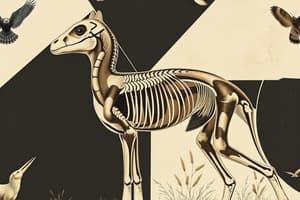Podcast
Questions and Answers
All mammals have a four-chambered heart.
All mammals have a four-chambered heart.
True (A)
Amphibians are warm-blooded.
Amphibians are warm-blooded.
False (B)
Reptiles have a three-chambered heart.
Reptiles have a three-chambered heart.
True (A)
Birds have a four-chambered heart.
Birds have a four-chambered heart.
Invertebrates have a backbone.
Invertebrates have a backbone.
All invertebrates are insects.
All invertebrates are insects.
Flashcards are hidden until you start studying
Study Notes
Mammals
- Warm-blooded (endothermic)
- Hair or fur present
- Three middle ear bones (ossicles)
- Mammary glands present for milk production
- Live birth (except for platypus and echidna)
- Brain development:
- Large cerebral cortex
- Neocortex divided into four lobes
- Examples: humans, lions, bears, whales, monkeys
Amphibians
- Cold-blooded (ectothermic)
- Moist, smooth skin
- Lay eggs in water
- Undergo metamorphosis from larva to adult
- Respire through skin and lungs
- Examples: frogs, toads, salamanders, newts
Reptiles
- Cold-blooded (ectothermic)
- Scaly skin
- Lay eggs on land
- Breathe air through lungs
- Heart with three or four chambers
- Examples: snakes, lizards, turtles, crocodiles, alligators
Birds
- Warm-blooded (endothermic)
- Feathers present
- Lay eggs on land
- Light skeleton with hollow bones
- Respiratory system adapted for flight
- Examples: sparrows, eagles, robins, penguins, ostriches
Invertebrates
- No backbone (vertebral column)
- Diverse group, including:
- Insects (bees, wasps, butterflies)
- Arachnids (spiders, scorpions)
- Mollusks (squid, octopuses, clams)
- Echinoderms (starfish, sea urchins)
- Worms (flatworms, roundworms)
- Crustaceans (crabs, lobsters, shrimp)
- Examples: ants, beetles, flies, worms, jellyfish
Mammals
- Characterized by being warm-blooded (endothermic) and having hair or fur
- Possess three middle ear bones (ossicles) for hearing
- Mammary glands present for milk production to nourish young
- Give birth to live young, except for platypus and echidna
- Brain development features a large cerebral cortex and a neocortex divided into four lobes
- Examples include humans, lions, bears, whales, and monkeys
Amphibians
- Cold-blooded (ectothermic) and have moist, smooth skin
- Lay eggs in water and undergo metamorphosis from larva to adult
- Respire through skin and lungs
- Examples include frogs, toads, salamanders, and newts
Reptiles
- Cold-blooded (ectothermic) and have scaly skin
- Lay eggs on land and breathe air through lungs
- Heart features three or four chambers
- Examples include snakes, lizards, turtles, crocodiles, and alligators
Birds
- Warm-blooded (endothermic) and have feathers
- Lay eggs on land and have a light skeleton with hollow bones
- Respiratory system adapted for flight
- Examples include sparrows, eagles, robins, penguins, and ostriches
Invertebrates
- Diverse group characterized by the absence of a backbone (vertebral column)
- Includes insects, arachnids, mollusks, echinoderms, worms, and crustaceans
- Examples include ants, beetles, flies, worms, jellyfish, and various others
Studying That Suits You
Use AI to generate personalized quizzes and flashcards to suit your learning preferences.




